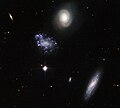Hickson Compact Group
| Alternative names | Hickson Galaxy Groups |
|---|---|
| | |
A Hickson Compact Group (abbreviation: HCG) is a collection of galaxies designated as published by Paul Hickson in 1982.[1]
The most famous group on Hickson's list of 100 objects is HCG 92, Stephan's Quintet.
Hickson Compact Groups
According to Hickson: “Most compact groups contain a high fraction of galaxies having morphological or kinematical peculiarities, nuclear radio and infrared emission, and starburst or active galactic nuclei (AGN) activity. They contain large quantities of diffuse gas and are dynamically dominated by dark matter. They most likely form as subsystems within looser associations and evolve by gravitational processes. Strong galaxy interactions result and merging is expected to lead to the ultimate demise of the group. Compact groups are surprisingly numerous, and may play a significant role in galaxy evolution.”[2]
List
| Image | HCG | Right ascension[3] | Declination[3] | Galaxy count[4] | Members | Notes |
|---|---|---|---|---|---|---|

|
1 | 00h 26.0m | +25° 43′ | 4 | UGC 248, PGC 1625, PGC 1614, PGC 1618 | |
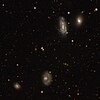
|
2 | 00h 31m 24s | +08° 26.8′ | 4 | UGC 312, Markarian 552, UGC 314, UGC 315 | |

|
3 | 00h 34m 11s | −07° 35.6′ | 4 | MCG-01-02-032, PGC 2064, PGC 2059, PGC 2043 | |

|
4 | 00h 34m 15.3s | −21° 26′ 52″ | 5 | ESO 540-1, ESO 540-2, PGC 2051, PGC 2057, PGC 2040 | |

|
5 | 00h 38m 54s | +07° 03.8′ | 4 | NGC 190, NGC 190S, MCG+01-02-042, PGC 2326 | |

|
6 | 00h 39m 10s | −08° 23.7′ | 4 | PGC 2347, PGC 2350, PGC 2351, PGC 2353 | |

|
7 | 00h 39m 15.9s | +00° 53′ 17″ | 4 | NGC 192, NGC 196, NGC 197, NGC 201 | Contains three spirals and one lenticular galaxy[5] |

|
8 | 00h 49m 37s | +23° 34.8′ | 4 | MCG+04-03-008, PGC 2888, PGC 2890, PGC 2892 | |

|
9 | 00h 54m 18s | −23° 33.1′ | 4 | MCG-04-03-027, MCG-04-03-028, PGC 3196, PGC 3200 | |

|
10 | 01h 26m 24.5s | +34° 42′ 51″ | 4 | NGC 536, NGC 529, NGC 531, NGC 542 | |

|
11 | 01h 26.6m | −23° 13′ | 4 | ESO 476-8, MCG-04-04-010, PGC 5357, PGC 5381 | |

|
12 | 01h 27m 33.7s | −04° 40′ 14″ | 5 | MCG-01-04-052, PGC 5432, PGC 5439, PGC 5443, PGC 5445 | |

|
13 | 01h 32.4m | −07° 52′ | 5 | MCG-01-05-002, MCG-01-05-003, MCG-01-05-004, PGC 5728, PGC 5741 | |

|
14 | 01h 59m 47s | −07° 01.7′ | 4 | MCG-01-06-017, MCG-01-06-019, MCG-01-06-020, MCG-01-06-022 | |
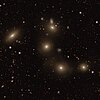
|
15 | 02h 07m 39.0s | +02° 08′ 18″ | 6 | UGC 1617, UGC 1618, UGC 1618 B, UGC 1620, UGC 1624, MCG+00-06-033 | |

|
16 | 02h 09m 31.3s | −10° 09′ 31″ | 4 | NGC 835, NGC 833, NGC 838, NGC 839 | Contains three starburst galaxies, two LINER galaxies, and a Seyfert 2 galaxy[6] |

|
17 | 02h 14m 04.5s | +13° 18′ 54″ | 5 | PGC 8558, PGC 8559, PGC 8560, PGC 8561, PGC 8564 | |

|
18 | 02h 39m 06.10s | +18° 23′ 02.0″ | 4 | MCG+03-07-038, UGC 2140 | |

|
19 | 02h 42m 45s | −12° 24.7′ | 4 | MCG-02-07-073, MCG-02-07-074, MCG-02-07-075, PGC 10269 | |
| 20 | 02h 44m 14s | +26° 06.2′ | 6 | PGC 10364, PGC 10365, PGC 10366, PGC 10367, PGC 10368, PGC 10369 | ||
| 21 | 02h 45m 16.9s | −17° 37′ 35″ | 5 | NGC 1099, NGC 1100, NGC 1098, NGC 1091, NGC 1092 | ||

|
22 | 03h 03m 31s | −15° 40.5′ | 5 | NGC 1199, NGC 1190, NGC 1189, NGC 1191, NGC 1192 | |

|
23 | 03h 07m 06s | −09° 35.1′ | 5 | NGC 1214, NGC 1215, NGC 1216, MCG-02-08-054 | |

|
24 | 03h 20.3m | −10° 51′ | 5 | MCG-02-09-031, MCG-02-09-032, PGC 12472, PGC 12492, PGC 12489 | |

|
25 | 03h 20m 43.7s | −01° 03′ 07″ | 7 | UGC 2690, UGC 2691, PGC 12524, PGC 12530, PGC 12533, PGC 12538, PGC 12550 | |

|
26 | 03h 21m 54s | −13° 38.8′ | 7 | MCG-02-09-035, HCG 26b, PGC 12604, PGC 12605, PGC 12610, PGC 12613, PGC 12615 | |

|
27 | 04h 19.4m | −11° 42′ | 6 | PGC 14861, PGC 14862, PGC 14863, PGC 14866, PGC 14870, PGC 14873 | |

|
28 | 04h 27m 19s | −10° 19.0′ | 4 | PGC 15135, PGC 15136, PGC 15141, HCGd 28d | |

|
29 | 04h 34m 45s | −30° 32.8′ | 4 | PGC 15559, PGC 15560, PGC 15561, PGC 15562 | |

|
30 | 04h 36.5m | −02° 49′ | 4 | MCG+00-12-051, MCG+00-12-054, PGC 15624, PGC 15636 | |

|
31 | 05h 01m 37s | −04° 15.4′ | 4 | NGC 1741A, PGC 16570, NGC 1741B, PGC 16571 | |

|
32 | 05h 01.7m | −15° 25′ | 4 | MCG-03-13-053, PGC 16578, PGC 16584, PGC 16587 | |
| 33 | 05h 10m 47.6s | +18° 01′ 11″ | 4 | PGC 16863, PGC 16866, PGC 16867, PGC 16871 | ||

|
34 | 05h 21m 47s | +06° 40.6′ | 4 | NGC 1875, VV 169b, VV 169c, VV 169d | |

|
35 | 08h 45m 20.71s | +44° 32′ 23.1″ | 6 | PGC 24596, PGC 24597, PGC 24598, PGC 24599, PGC 24600, PGC 24601 | |

|
36 | 09h 09m 24s | +15° 47.7′ | 4 | IC 528, IC 528C, PGC 25782, PGC 25791 | |

|
37 | 09h 13m 35.6s | +30° 00′ 51″ | 5 | NGC 2783, UGC 4856, MCG+05-22-016, MCG+05-22-018, MCG+05-22-020, | |

|
38 | 09h 27.6m | +12° 16′ | 4 | MCG+02-24-012, UGC 5044, MCG+02-24-014, PGC 26830 | |

|
39 | 09h 29m 28s | −01° 20.7′ | 4 | PGC 26925, PGC 26926, PGC 26929, PGC 26931 | |

|
40 | 09h 38m 54s | −04° 51.1′ | 6 | MCG-01-25-008, MCG-01-25-009, MCG-01-25-010, MCG-01-25-011, MCG-01-25-012, PGC 27517 | also known as Arp 321 |

|
41 | 09h 57m 40s | +45° 14.4′ | 4 | UGC 5345, UGC 5346, MCG+08-18-046, PGC 28784 | |

|
42 | 10h 00m 13.1s | −19° 38′ 24″ | 4 | NGC 3091, NGC 3096, MCG-03-26-006, PGC 28926 | also known as NGC 3091 Group |

|
43 | 10h 11.2m | −00° 01′ | 6 | Z 8-59, Z 8-61, Z 8-62, PGC 29666, PGC 29668, PGC 29673 | |

|
44 | 10h 18m 00s | +21° 48.7′ | 4 | NGC 3185, NGC 3187, NGC 3190, NGC 3193 | |

|
45 | 10h 19.2m | +59° 06′ | 4 | UGC 5564, PGC 30137, PGC 30143, PGC 30156 | |

|
46 | 10h 22.0m | +17° 48′ | 4 | MCG+03-27-005, MCG+03-27-007, MCG+03-27-008, MCG+03-27-009 | |

|
47 | 10h 25m 48s | +13° 43.9′ | 4 | UGC 5644, MCG+02-27-013, MCG+02-27-014, MCG+02-27-015 | |

|
48 | 10h 37m 45.6s | −27° 04′ 50″ | 4 | IC 2597, ESO 501-59, PGC 31577, PGC 31580 | |
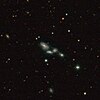
|
49 | 10h 56m 36s | +67° 10.8′ | 4 | PGC 32890, PGC 32893, PGC 32895, PGC 32899 | |

|
50 | 11h 17m 06s | +54° 55.1′ | 5 | PGC 34444, PGC 34447, PGC 34448, PGC 34452, PGC 34453 | |

|
51 | 11h 22m 21.6s | +24° 19′ 41″ | 7 | NGC 3651, NGC 3653, IC 2759, MCG+04-27-030, MCG+04-27-027, PGC 34899, PGC 34901 | |

|
52 | 11h 26.3m | +21° 05′ | 4 | MCG+04-27-036, PGC 35178, PGC 35179, PGC 35184, | |

|
53 | 11h 28m 58s | +20° 46.6′ | 4 | NGC 3697, Mrk 1296, MCG+04-27-044, PGC 35381 | |

|
54 | 11h 29m 15s | +20° 34.7′ | 4 | IC 700 | |

|
55 | 11h 32m 07s | +70° 48.7′ | 5 | PGC 35573, PGC 35574, PGC 35575, 2MASX J11320571+7048236, HCG 55e | |

|
56 | 11h 32m 32s | +52° 56.9′ | 5 | MCG+09-19-113, Mrk 176, PGC 35609, PGC 35615, PGC 35618 | south of NGC 3718 and a popular target for amateur astronomers |

|
57 | 11h 37m 50.5s | +21° 59′ 06″ | 8 | NGC 3753, NGC 3746, NGC 3750, NGC 3754, NGC 3748, NGC 3751, NGC 3745, PGC 36010 | Also known as Copeland Septet |

|
58 | 11h 42m 09.4s | +10° 16′ 30″ | 5 | NGC 3817, NGC 3819, NGC 3820, NGC 3822, NGC 3825, | |

|
59 | 11h 48m 27s | +12° 43.0′ | 5 | IC 737, IC 736, PGC 36871, PGC 36867, PGC 36851 | |

|
60 | 12h 03m 05s | +51° 41.6′ | 4 | MCG+09-20-071, PGC 38053, PGC 38064, PGC 38072 | |

|
61 | 12h 12m 24s | +29° 10.7′ | 4 | NGC 4169, NGC 4170, NGC 4174, NGC 4175 | |

|
62 | 12h 53m 05.6s | −09° 12′ 21″ | 4 | NGC 4759, NGC 4761, NGC 4764, NGC 4776, NGC 4778 | |
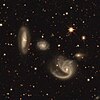
|
63 | 13h 02.2m | −32° 46′ | 4 | ESO 381-50, ESO 443-37, PGC 44959, PGC 44979 | |

|
64 | 13h 25m 43s | −03° 51.5′ | 4 | PGC 46971, PGC 46972, PGC 46975, PGC 46977, | |

|
65 | 13h 29m 53s | −29° 30.0′ | 5 | ESO 444-55, PGC 47401, PGC 47403, PGC 47406, PGC 47407 | |

|
66 | 13h 38m 33s | +57° 18.3′ | 4 | MCG+10-19-104, PGC 48220, PGC 48231, PGC 48222 | |

|
67 | 13h 49m 03.5s | −07° 12′ 20″ | 4 | NGC 5306, MCG-01-35-013, MCG-01-35-015, PGC 49036 | |

|
68 | 13h 53m 40.9s | +40° 19′ 07″ | 5 | NGC 5350, NGC 5353, NGC 5354, NGC 5355, NGC 5358 | |

|
69 | 13h 55m 31s | +25° 03.8′ | 4 | UGC 8842, Z 132-48, MCG+04-33-028, PGC 49499 | HCG 69 is surrounded by other galaxies, such as IC 4343, IC 4344, IC 4345, IC 4346, IC 4348 and IC 4349 |

|
70 | 14h 04m 07.4s | +33° 19′ 10″ | 7 | IC 4369, IC 4370, IC 4371, UGC 8990, MCG+06-31-057, MCG+06-31-065, PGC 50123 | |

|
71 | 14h 11.1m | +25° 29′ | 4 | NGC 5008, IC 4382, PGC 50640, PGC 50641 | |

|
72 | 14h 47m 55s | +19° 03.6′ | 6 | UGC 9532, MCG+03-38-017, MCG+03-38-018, MCG+03-38-018, MCG+03-38-020, MCG+03-38-022 | |

|
73 | 15h 02m 40.1s | +23° 21′ 13″ | 5 | NGC 5829, IC 4526, PGC 53702, PGC 53703, PGC 53720 | |

|
74 | 15h 19m 28s | +20° 53.6′ | 5 | NGC 5910, MCG+04-36-036, PGC 54692, PGC 54694, PGC 54697 | |
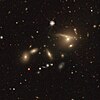
|
75 | 15h 21m 37.0s | +21° 10′ 50″ | 6 | PGC 54802, PGC 54803, PGC 54804, PGC 54818, PGC 54824, PGC 54827 | |

|
76 | 15h 31.7m | +07° 18′ | 5 | NGC 5941, NGC 5942, NGC 5944, MCG+01-40-003, PGC 55313, PGC 55325 | |

|
77 | 15h 49m 17s | +21° 49.7′ | 4 | UGC 10049, PGC 56121, PGC 56122, PGC 56125 | |

|
78 | 15h 48.5m | +68° 12′ | 4 | UGC 10057, MCG+11-19-016, PGC 56086, PGC 56095 | |

|
79 | 15h 59m 13s | +20° 45.1′ | 5 | NGC 6027, NGC 6027a, NGC 6027b, NGC 6027c, NGC 6027d, NGC 6027e (tidal tail of NGC 6027) | Also known as UGC 10116, VV 115, Seyfert's Sextet or Serpens Sextet. Contains 2 lenticular galaxies, 3 spiral galaxies (one barred spiral) and a tidal tail. |
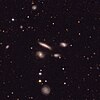
|
80 | 15h 59m 12s | +65° 13.6′ | 4 | PGC 56572, PGC 56577, PGC 56588, PGC 56590 | |

|
81 | 16h 18m 13s | +12° 47.6′ | 4 | SDSS J161813.66+124811.2, PGC 57774, PGC 57777, PGC 57779 | |

|
82 | 16h 28m 22.1s | +32° 49′ 25″ | 4 | NGC 6161, NGC 6162, NGC 6163, PGC 58231 | |

|
83 | 16h 35m 40.9s | +06° 16′ 12″ | 5 | PGC 58559, PGC 58561, PGC 58562, PGC 58565, PGC 58569 | |
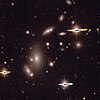
|
84 | 16h 44m 08s | +77° 50.2′ | 6 | PGC 58856, PGC 58861, PGC 58873, PGC 58877, PGC 58881, PGC 58884 | |

|
85 | 18h 50m 22.3s | +73° 21′ 00″ | 4 | PGC 62476, PGC 62477, PGC 62478, PGC 62484, | |

|
86 | 19h 51m 59.2s | −30° 49′ 34″ | 4 | ESO 461-7, MCG-05-47-001, MCG-05-47-002, MCG-05-47-003, | |

|
87 | 20h 48m 11s | −19° 50.4′ | 4 | ESO 597-36, PGC 65409, ESO 597-35, PGC 65414 | One of the most compact groups, hosting two active galactic nuclei and a starburst among its three members, all of which show signs of interaction |

|
88 | 20h 52.4m | −05° 45′ | 4 | NGC 6978, NGC 6976, NGC 6977, MCG-01-53-014 | |

|
89 | 21h 20.2m | −03° 54′ | 4 | MCG-01-54-012, PGC 66574, PGC 66575, PGC 66580 | |
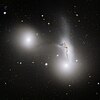
|
90 | 22h 02m 06.3s | −31° 55′ 48″ | 4 | NGC 7173, NGC 7174, NGC 7176, and NGC 7172 | also called NGC 7176 Group |
| 91 | 22h 09m 00.8s | −27° 47′ 36″ | 4 | NGC 7214, ESO 467-15, ESO 467-13, HCG 91d | also called VV 700 Group | |

|
92 | 22h 35m 57.5s | +33° 57′ 36″ | 5 | NGC 7317, NGC 7318A, NGC 7318B, NGC 7319, NGC 7320C | Also called Stephan's Quintet, one galaxy of the sixsome, NGC 7320, is not part of the HCG but is a foreground galaxy in front of the five galaxies in the HCG. When discovered, two of the galaxies in the grouping were considered to be one galaxy, NGC 7318. |

|
93 | 23h 15m 12.2s | +18° 59′ 31″ | 5 | NGC 7547, NGC 7549, NGC 7550, NGC 7553, NGC 7558 | |

|
94 | 23h 17m 16.5s | +18° 43′ 11″ | 7 | NGC 7578, UGC 12477, PGC 70936, PGC 70937, PGC 70939, PGC 70941, PGC 70943, | |
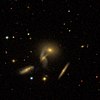
|
95 | 23h 19m 32s | +09° 29.5′ | 4 | NGC 7609, MCG+01-59-046, PGC 71077, PGC 71080 | also called Arp 150 Group and NGC 7609 Group |

|
96 | 23h 27m 58s | +08° 46.4′ | 4 | NGC 7674, NGC 7674A, NGC 7675, PGC 71507 | |

|
97 | 23h 47m 24.0s | −02° 19′ 08″ | 5 | IC 5351, IC 5352, IC 5356, IC 5357, IC 5359 | |

|
98 | 23h 54.2m | +00° 22′ | 4 | NGC 7783, MCG+00-60-059, PGC 72810, NGC 7783 C | In 2019 a giant tidal tail and a large envelope was discovered around HCG 98 with the Wise Observatory[7] |

|
99 | 00h 00m 43s | +28° 23.7′ | 4 | UGC 12897, UGC 12899, MCG+05-01-021, PGC 60, PGC 57 | |

|
100 | 00h 01.3m | +13° 07′ | 4 | NGC 7803, Mrk 934, MCG+02-01-009, MCG+02-01-010 |
Gallery
- The four members of HCG 44 by Hunter Wilson
- NGC 3718 and HCG 56 (bottom). Image from the legacy surveys
See also
References
- ^ Hickson, Paul (1982). "Systematic properties of compact groups of galaxies". Astrophysical Journal. 255: 382–391. Bibcode:1982ApJ...255..382H. doi:10.1086/159838.
- ^ "Compact Groups of Galaxies". Retrieved 23 October 2006.
- ^ a b "HCG". SIMBAD. Centre de données astronomiques de Strasbourg. Retrieved 8 March 2017.
- ^ Hickson, P. (1982). "Systematic properties of compact groups of galaxies". Astrophysical Journal. 255: Part 1, 382–391. Bibcode:1982ApJ...255..382H. doi:10.1086/159838.
- ^ "Anne's Picture of the Day: Hickson Compact Group 7". Anne's Astronomy News. 27 December 2012.
- ^ "Hubble views a bizarre cosmic quartet". Space Daily. 22 June 2015.
- ^ Brosch, Noah; Koriski, Shuki; Rich, R. Michael; Mosenkov, Alexandr V. (1 January 2019). "Hickson Compact Group 98: a complex merging group with a giant tidal tail and a humongous envelope". Monthly Notices of the Royal Astronomical Society. 482 (2): 2284–2293. Bibcode:2019MNRAS.482.2284B. doi:10.1093/mnras/sty2717. ISSN 0035-8711.
- ^ "A fossil in the making". ESA/Hubble Picture of the Week. Retrieved 3 July 2014.
- ^ "A members-only galaxy club". ESA/Hubble Picture of the Week. Retrieved 10 December 2013.
Further reading
- Paul Hickson (15 April 1982). "Systematic properties of compact groups of galaxies". Astrophysical Journal, Part 1. 255: 382–391. Bibcode:1982ApJ...255..382H. doi:10.1086/159838.
- Paul Hickson (25 October 1997). "Compact Groups of Galaxies". Annual Review of Astronomy and Astrophysics. 35: 357–388. arXiv:astro-ph/9710289. Bibcode:1997ARA&A..35..357H. doi:10.1146/annurev.astro.35.1.357. S2CID 18870169.
External links
- Astronomy Picture of the Day – Galaxy Group Hickson 31 – 22 February 2010

![NGC 201 is a barred spiral galaxy similar to the Milky Way, a member of HCG 7[8]](Https://upload.wikimedia.org/wikipedia/commons/thumb/1/14/A_fossil_in_the_making.jpg/120px-A_fossil_in_the_making.jpg)
![HCG 22 by Hubble Space Telescope[9]](Https://upload.wikimedia.org/wikipedia/commons/thumb/c/ca/A_members-only_galaxy_club.jpg/120px-A_members-only_galaxy_club.jpg)
